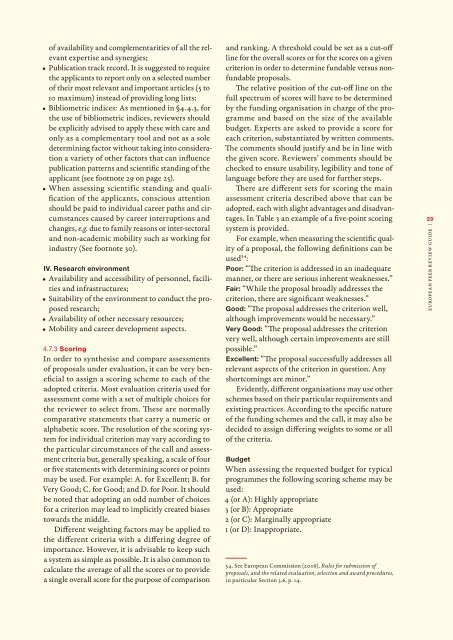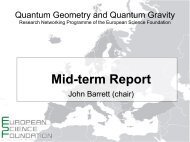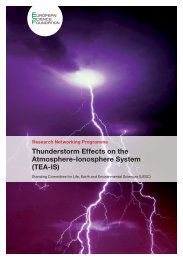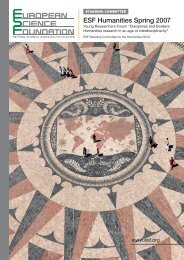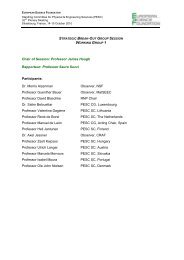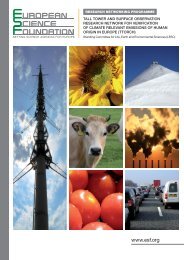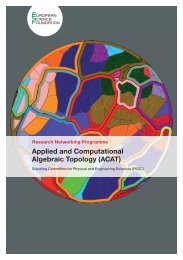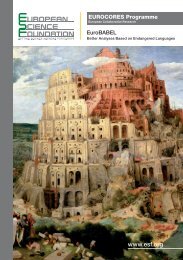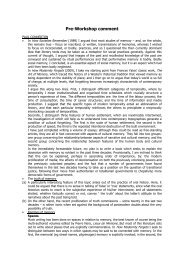European Peer Review Guide - European Science Foundation
European Peer Review Guide - European Science Foundation
European Peer Review Guide - European Science Foundation
You also want an ePaper? Increase the reach of your titles
YUMPU automatically turns print PDFs into web optimized ePapers that Google loves.
of availability and complementarities of all the relevant<br />
expertise and synergies;<br />
• Publication track record. It is suggested to require<br />
the applicants to report only on a selected number<br />
of their most relevant and important articles (5 to<br />
10 maximum) instead of providing long lists;<br />
• Bibliometric indices: As mentioned in §4.4.3, for<br />
the use of bibliometric indices, reviewers should<br />
be explicitly advised to apply these with care and<br />
only as a complementary tool and not as a sole<br />
determining factor without taking into consideration<br />
a variety of other factors that can influence<br />
publication patterns and scientific standing of the<br />
applicant (see footnote 29 on page 25).<br />
• When assessing scientific standing and qualification<br />
of the applicants, conscious attention<br />
should be paid to individual career paths and circumstances<br />
caused by career interruptions and<br />
changes, e.g. due to family reasons or inter-sectoral<br />
and non-academic mobility such as working for<br />
industry (See footnote 30).<br />
IV. Research environment<br />
• Availability and accessibility of personnel, facilities<br />
and infrastructures;<br />
• Suitability of the environment to conduct the proposed<br />
research;<br />
• Availability of other necessary resources;<br />
• Mobility and career development aspects.<br />
4.7.3 Scoring<br />
In order to synthesise and compare assessments<br />
of proposals under evaluation, it can be very beneficial<br />
to assign a scoring scheme to each of the<br />
adopted criteria. Most evaluation criteria used for<br />
assessment come with a set of multiple choices for<br />
the reviewer to select from. These are normally<br />
comparative statements that carry a numeric or<br />
alphabetic score. The resolution of the scoring system<br />
for individual criterion may vary according to<br />
the particular circumstances of the call and assessment<br />
criteria but, generally speaking, a scale of four<br />
or five statements with determining scores or points<br />
may be used. For example: A. for Excellent; B. for<br />
Very Good; C. for Good; and D. for Poor. It should<br />
be noted that adopting an odd number of choices<br />
for a criterion may lead to implicitly created biases<br />
towards the middle.<br />
Different weighting factors may be applied to<br />
the different criteria with a differing degree of<br />
importance. However, it is advisable to keep such<br />
a system as simple as possible. It is also common to<br />
calculate the average of all the scores or to provide<br />
a single overall score for the purpose of comparison<br />
and ranking. A threshold could be set as a cut-off<br />
line for the overall scores or for the scores on a given<br />
criterion in order to determine fundable versus nonfundable<br />
proposals.<br />
The relative position of the cut-off line on the<br />
full spectrum of scores will have to be determined<br />
by the funding organisation in charge of the programme<br />
and based on the size of the available<br />
budget. Experts are asked to provide a score for<br />
each criterion, substantiated by written comments.<br />
The comments should justify and be in line with<br />
the given score. <strong>Review</strong>ers’ comments should be<br />
checked to ensure usability, legibility and tone of<br />
language before they are used for further steps.<br />
There are different sets for scoring the main<br />
assessment criteria described above that can be<br />
adopted, each with slight advantages and disadvantages.<br />
In Table 3 an example of a five-point scoring<br />
system is provided.<br />
For example, when measuring the scientific quality<br />
of a proposal, the following definitions can be<br />
used34:<br />
Poor: “The criterion is addressed in an inadequate<br />
manner, or there are serious inherent weaknesses.”<br />
Fair: “While the proposal broadly addresses the<br />
criterion, there are significant weaknesses.”<br />
Good: “The proposal addresses the criterion well,<br />
although improvements would be necessary.”<br />
Very Good: “The proposal addresses the criterion<br />
very well, although certain improvements are still<br />
possible.”<br />
Excellent: “The proposal successfully addresses all<br />
relevant aspects of the criterion in question. Any<br />
shortcomings are minor.”<br />
Evidently, different organisations may use other<br />
schemes based on their particular requirements and<br />
existing practices. According to the specific nature<br />
of the funding schemes and the call, it may also be<br />
decided to assign differing weights to some or all<br />
of the criteria.<br />
Budget<br />
When assessing the requested budget for typical<br />
programmes the following scoring scheme may be<br />
used:<br />
4 (or A): Highly appropriate<br />
3 (or B): Appropriate<br />
2 (or C): Marginally appropriate<br />
1 (or D): Inappropriate.<br />
34. See <strong>European</strong> Commission (2008), Rules for submission of<br />
proposals, and the related evaluation, selection and award procedures,<br />
in particular Section 3.6, p. 14.<br />
29<br />
<strong>European</strong> <strong>Peer</strong> <strong>Review</strong> <strong>Guide</strong>


